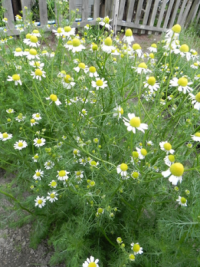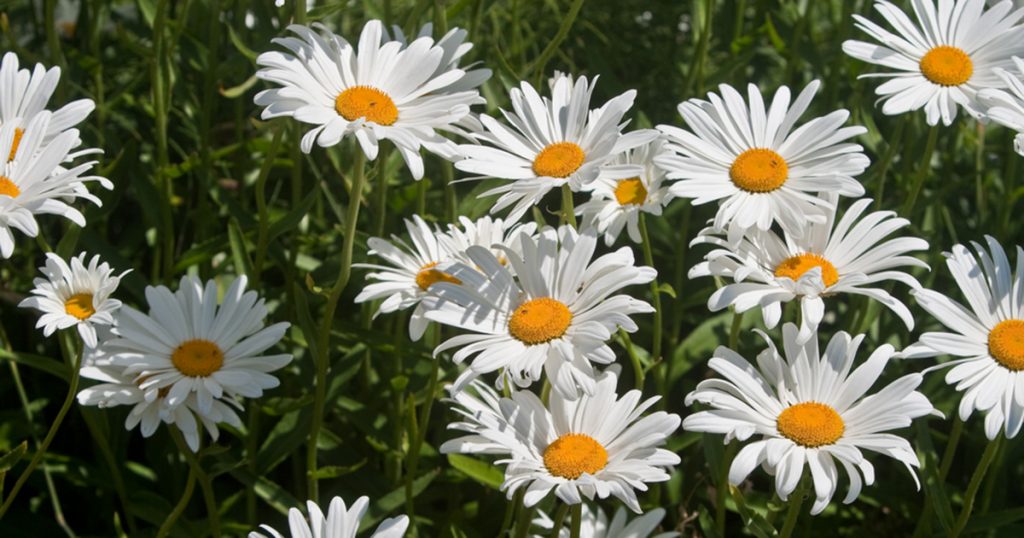Monthly Feature SEPTEMBER 2014
Chamomile is a fragrant, flowering herb, generally used as a relaxing tea.
But, did you know there are beneficial uses in the garden and for your plants?
There are actually two types of Chamomile, German and Roman.

German Chamomile, Matricaria recutita, an annual type, is the most common variety used for tea and as seed or transplants for the garden.
Roman Chamomile, Anthemis nobilis, is a perennial type and grows differently than the German variety, closer to the ground. The flowers are more difficult to pick and the taste is stronger. It’s used as a fragrant, flowering groundcover as well as a medicinal herb. It is quite cold tolerant, but not terribly heat tolerant.


In the Garden
Here in South Central Texas, German chamomile is considered a cool season annual.
It grows from fall through mid-spring, flowering ending when the extreme heat arrives. Until then, I can harvest chamomile continuously. The plant will keep producing flowers as long as I keep harvesting them.
Another aspect of chamomile I especially like is that, for me, it reseeds.
It’s never invasive, but starts to pop up here and there as the weather cools down in the early fall and we start to receive some rain. As I love the flowers for tea and other uses, I’m happy to see it anywhere it decides to grow. It’s such a cheery plant. And, the aroma of the whole plant when brushed up against is of apples and springtime. Very fresh and invigorating.
Seeding
The seeds of chamomile are tiny and need to be seeded on top of the soil, not buried. The seed needs light to germinate. Simply press the seed into the soil whether you’re direct seeding in the garden or seeding in containers or for transplants.
In colder climates, chamomile can be started indoors about 6 – 8 weeks before your last frost, so it’s ready to be planted out. I have found the plants to be hardy to light frosts down to about 30 deg. F.
Harvesting
To harvest the little flowers for drying is somewhat tedious, they’re so small. But, it’s worth it!
Clip or pinch the flowers off and dry them on a screen or some other material where airflow is provided. If you don’t want the trouble of harvesting each flower, clip whole branches, bundle them and hang them to dry. The leaves as well as the flowers can be used for tea. Or, simply pull the whole plant, hang it and let it dry. Then, remove the flowers and the leaves from the stems.
As with any dried herb, store the dried chamomile in an air tight container.
Chamomile does well in mixed herb containers. Its bright white and yellow flowers contrast nicely with leafy herbs such as parsley, oregano, thyme and rosemary. It will grow to about 12-15 inches tall.
Uses of Chamomile
Roman Chamomile, Chamaemelum nobile, Anthemis nobilis
Roman Chamomile has the same action and is often used interchangeably with German chamomile for stomach upset and its calming effect. But, the Roman when brewed into tea has a more active bitter action.
That is, as with other bitter herbs, it stimulates digestive secretions to better utilize food and normalize our digestive function. The tea is often taken as a remedy for headaches and migraines and is said to be safe for children. A strong decoction has been used topically for irritated skin. It has been used for centuries to relax the body and mind.
A note of caution: if you suffer from ragweed allergies, drink chamomile sparingly, if at all. The two plants are in the same family and drinking chamomile can trigger allergic symptoms.
Ailing plants are said to be helped by planting chamomile nearby.
Adding some chamomile tea to the water for cut flowers is said to lengthen their life in the vase. Spraying seedlings with chamomile tea is said to kill the damping off fungus.
If you live in a climate with moderate summer temperatures, this herb would be a lovely ground cover for you. According to the ancient Greeks, Roman chamomile is a symbol of humility because the more it was trod upon, the faster and more robustly it grew!
In the language of flowers, it means patience in adversity.
German chamomile, Matricaria recutita, also known in Spanish as manzanilla, little apple, is the more common herb we use for tea.
It has the same beneficial properties as the Roman variety for digestion, relieving cramping, aiding sleep and general relaxation.
The following is from Todd’s Seeds:
It is no secret that chamomile has properties to relax the body and mind. However, drinking chamomile tea has many other benefits.
Recent scientific studies by the American Chemical Society have proven that manzanilla increases glycine, which relieves muscle spasms. This makes effective for relieving menstrual cramps in women.
It also increased levels of hippurate, which are associated with boosting the immune system and fighting off certain infections. Its relaxation properties also help to battle insomnia.
Finally, manzanilla also contains chamazulene, which has anti-inflammatory properties that may help individuals with rheumatism, gastritis, or arthritis.
Cosmetic Uses
Rinsing hair with a strong decoction of chamomile will lighten and brighten blond hair. The tea will condition any hair type, but you need to be a blond for it to make a difference in color. Simply make a strong tea from chamomile leaves and/or flowers and pour it over your hair after shampooing. No need to rinse.
The tea makes a lovely facial rinse, too and can be applied to skin irritations, bites and such. A salve made with chamomile infused oil would be more effective than the simple tea since it would adhere to the skin more effectively. But, if you find chamomile effective for skin issues, the tea works perfectly well.
It’s Fall in Texas, the perfect time to plant some chamomile in your garden or empty container. If you live where chamomile grows in the summer, you must be harvesting it now. If you don’t care to grow chamomile yourself or have no where to grow it- purchase some chamomile tea. It’s easy to find.

Whichever situation you find yourself in, enjoy some chamomile tea this winter.

QUOTE FOR THE MONTH
Every gun that is made, every warship launched, every rocket fired signifies, in the final sense, a theft from those who hunger and are not fed, those who are cold and are not clothed.
-Dwight D. Eisenhower, US general and 34th president (1890-1969)
